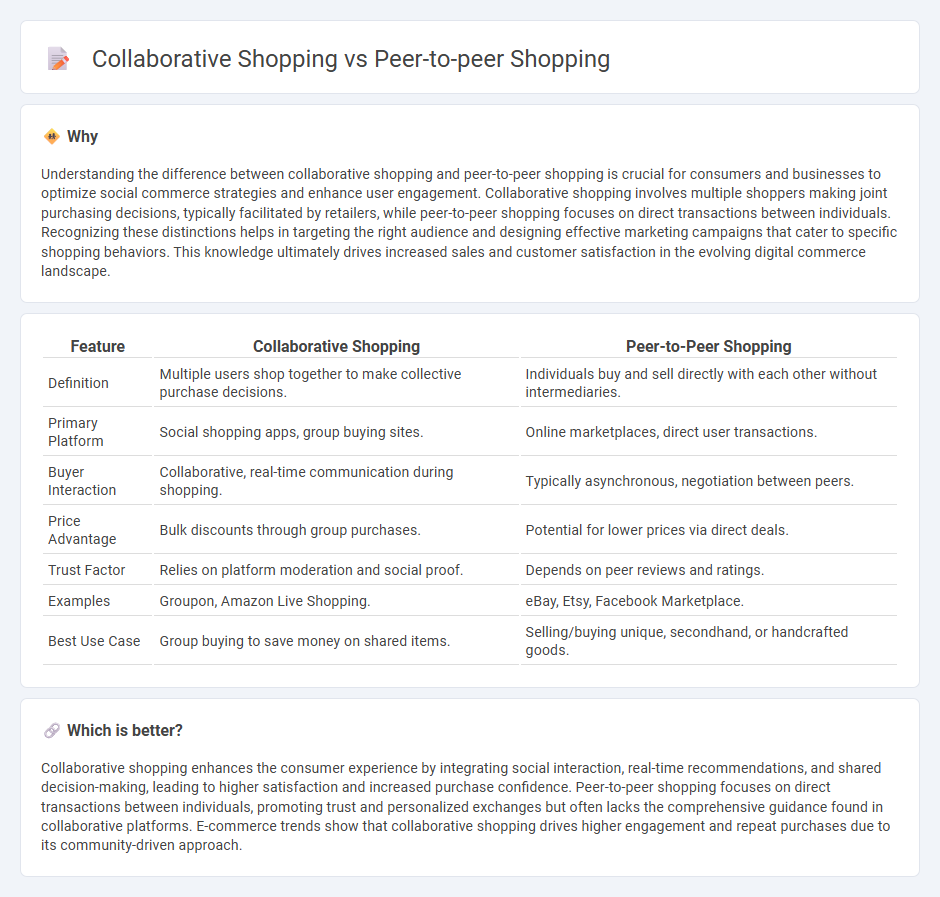
Collaborative shopping leverages group participation to enhance purchasing power, allowing consumers to pool resources and access exclusive deals or bulk discounts. Peer-to-peer shopping focuses on direct transactions between individuals, fostering a decentralized marketplace that promotes trust and personalized exchanges. Explore the distinctions between these innovative commerce models to optimize your shopping experience.
Why it is important
Understanding the difference between collaborative shopping and peer-to-peer shopping is crucial for consumers and businesses to optimize social commerce strategies and enhance user engagement. Collaborative shopping involves multiple shoppers making joint purchasing decisions, typically facilitated by retailers, while peer-to-peer shopping focuses on direct transactions between individuals. Recognizing these distinctions helps in targeting the right audience and designing effective marketing campaigns that cater to specific shopping behaviors. This knowledge ultimately drives increased sales and customer satisfaction in the evolving digital commerce landscape.
Comparison Table
| Feature | Collaborative Shopping | Peer-to-Peer Shopping |
|---|---|---|
| Definition | Multiple users shop together to make collective purchase decisions. | Individuals buy and sell directly with each other without intermediaries. |
| Primary Platform | Social shopping apps, group buying sites. | Online marketplaces, direct user transactions. |
| Buyer Interaction | Collaborative, real-time communication during shopping. | Typically asynchronous, negotiation between peers. |
| Price Advantage | Bulk discounts through group purchases. | Potential for lower prices via direct deals. |
| Trust Factor | Relies on platform moderation and social proof. | Depends on peer reviews and ratings. |
| Examples | Groupon, Amazon Live Shopping. | eBay, Etsy, Facebook Marketplace. |
| Best Use Case | Group buying to save money on shared items. | Selling/buying unique, secondhand, or handcrafted goods. |
Which is better?
Collaborative shopping enhances the consumer experience by integrating social interaction, real-time recommendations, and shared decision-making, leading to higher satisfaction and increased purchase confidence. Peer-to-peer shopping focuses on direct transactions between individuals, promoting trust and personalized exchanges but often lacks the comprehensive guidance found in collaborative platforms. E-commerce trends show that collaborative shopping drives higher engagement and repeat purchases due to its community-driven approach.
Connection
Collaborative shopping and peer-to-peer shopping both rely on consumer interaction and shared experiences to enhance purchasing decisions, leveraging social proof and trust within communities. These models utilize digital platforms to facilitate direct communication and transactions between buyers, promoting transparency and personalized recommendations. By integrating user-generated content and collaborative tools, they transform traditional commerce into more engaging and consumer-driven processes.
Key Terms
Decentralization
Peer-to-peer shopping emphasizes decentralization by enabling direct transactions between buyers and sellers without intermediaries, fostering trust through blockchain technology and smart contracts. Collaborative shopping, while also promoting user engagement, often relies on centralized platforms that coordinate group buying decisions and discounts. Explore how decentralization transforms the future of digital commerce and consumer autonomy.
Group Buying
Group buying leverages the collective purchasing power of peer-to-peer networks to secure significant discounts on bulk orders, enhancing affordability and value for participants. Collaborative shopping emphasizes real-time cooperation among users to select products and share opinions, fostering an engaging and socially connected buying experience. Explore more about how group buying transforms e-commerce by uniting communities for better deals and smarter spending.
Social Interaction
Peer-to-peer shopping emphasizes direct transactions between individual buyers and sellers, fostering personalized social interactions and trust within decentralized networks. Collaborative shopping centers on group engagement, where users share preferences and make joint purchase decisions, enhancing collective social experiences. Explore deeper insights into how these social interaction models shape consumer behavior and community building.
Source and External Links
What is peer to peer marketplace? How to build a p2p website - Peer-to-peer (P2P) shopping refers to online marketplaces where individuals sell products directly to other individuals without intermediaries, leading to more transparency and no commission fees commonly seen in traditional models.
How to Build a Peer-to-Peer Marketplace Platform, 2025 | Clarity - P2P marketplaces promote a sharing economy, enabling buyers and sellers to connect while reducing startup costs and facilitating access to larger global markets, which benefits individuals and small businesses alike.
Peer-to-peer marketplace guide: How to launch, grow, and scale ... - Peer-to-peer shopping marketplaces have seen rapid growth as affordable, convenient alternatives to traditional eCommerce, with the sector expected to reach billions in value, driven by consumer demand for sustainable and direct buying options.
 dowidth.com
dowidth.com